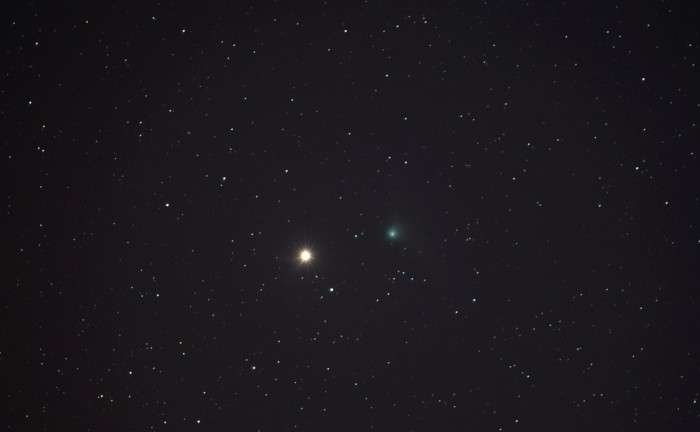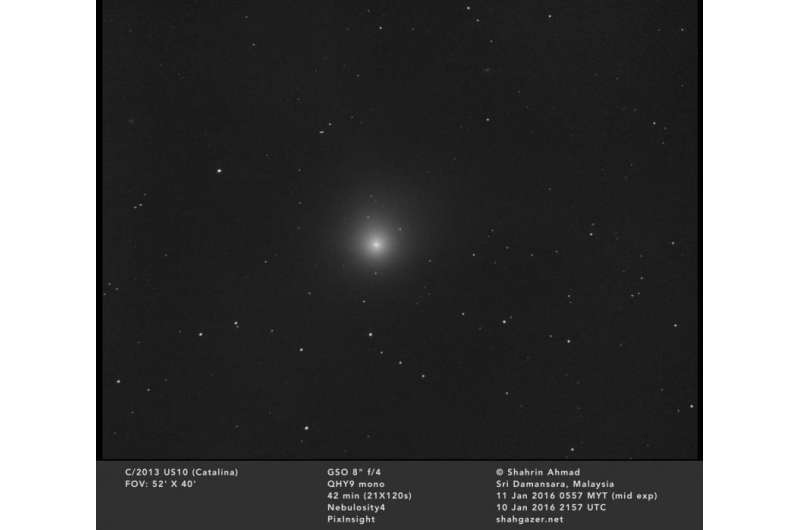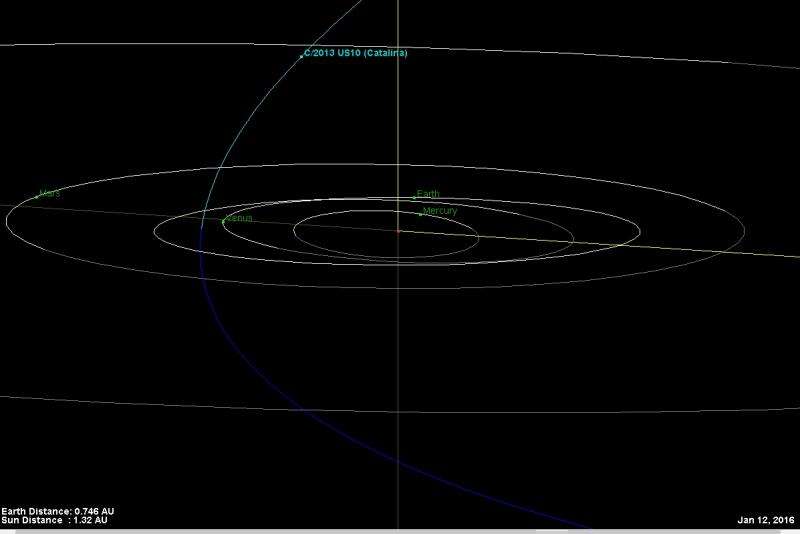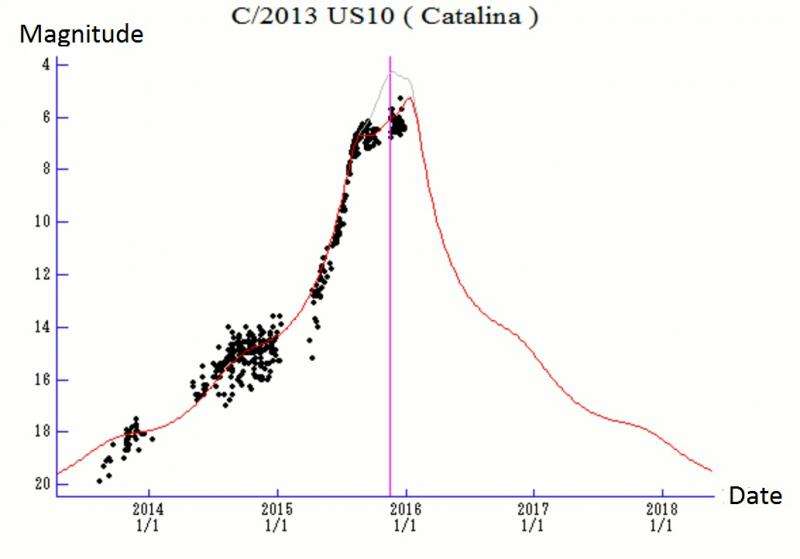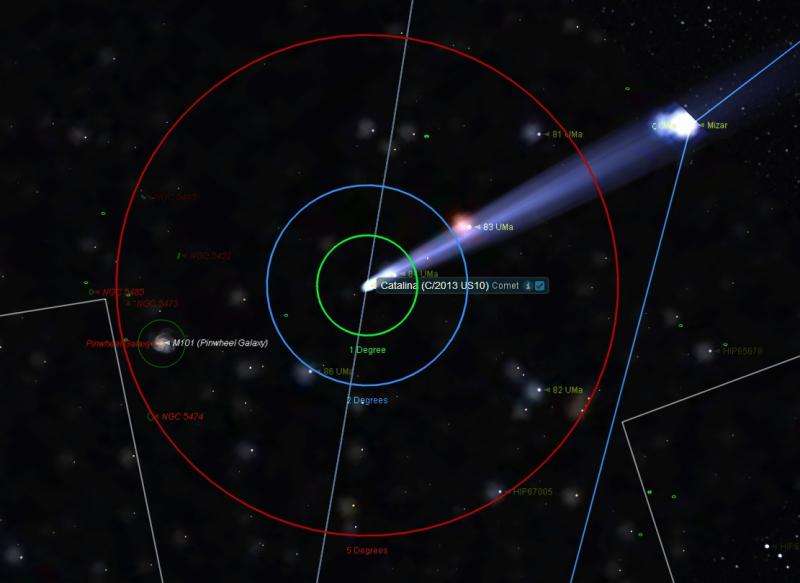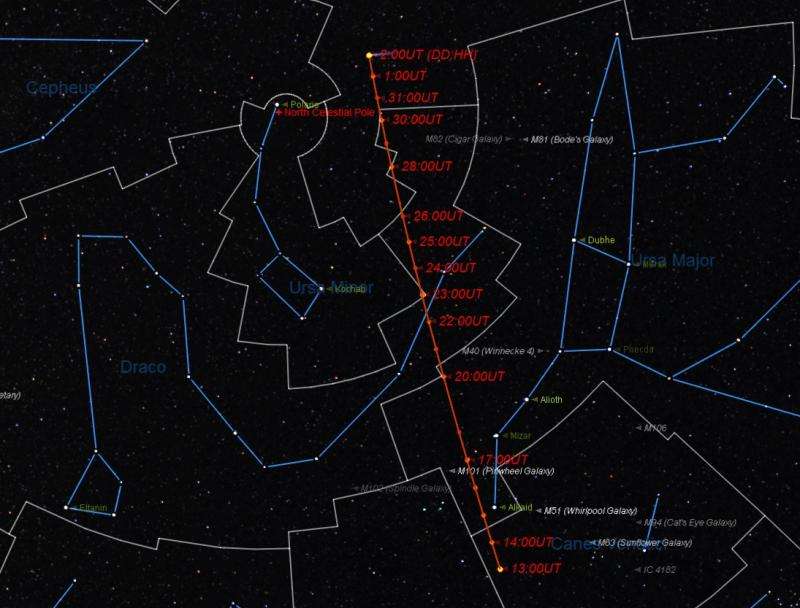Comet US10 Catalina passes near the bright star Arcturus on January 1st. Credit: Alan Tough
Have you seen it? 2016 has kicked off with a fine apparition of a binocular comet: C/2013 US10 Catalina. We've been following this icy visitor to the inner solar system the first few mornings of the year, a welcome addition to the morning planetary line-up.
Astrophotographers have generated some amazing images Comet US10 Catalina as it glided past the bright star Arcturus on New Year's Day through the constellation Boötes. We've written about the early stages of acts one and two back in 2015 for this fine comet; now, January 2016 sees the final act, a performance that finds this comet at its best for northern hemisphere observers this week into the next.
First, the story thus far: Comet US10 Catalina was discovered on October 31st, 2013 during the routine Catalina Sky Survey sweeping the sky for comets and asteroids. The bizarre 'US10' designation speaks to the legacy of its original mis-designation as an asteroid, before its cometary nature became known.
Comet US10 Catalina has an orbit that is inclined relatively high at 149 degrees (or 31 degrees, if its retrograde orbit isn't accounted for) relative to the ecliptic. One of the stranger facts about comets is that their dust tail is blown back by the solar wind and always points away from the Sun… this means that the dust tail of a comet precedes it on its outbound leg, as Comet US10 Catalina is doing now. Visually, Comet US10 Catalina currently looks like an unresolved +6th magnitude globular cluster in binoculars, with just a hint of a spiky tail… deep sky images bring out a long graceful dust tail, with an opposing ion tail pushed back along the plane of the comet's orbit.
Comet US10 Catalina from January 11th. Credit: Sharin Ahmad @shahgazer
This week at it closest, Comet US10 Catalina will cross the constellation Canes Venatici into Ursa Major moving at a respectable 2.5 degrees (more than 5 times the diameter of a Full Moon) a day.
The comet just reached perihelion at 0.8 AU from the Sun on November 16th, 2015, and its currently observed brightness sits at magnitude +6.5.
The time to catch Comet US10 Catalina is now, before the pesky waxing Moon begins to interfere late next week. The comet is practically circumpolar for a good swath of northern hemisphere observers through mid-January, and rides highest in the sky at around 6 AM local, just before sunrise.
Comet US10 Catalina’s orbit. Credit: NASA/JPL
Here's a blow-by-blow of what to expect from Comet C/2013 US10 Catalina through the remainder of the month of January 2016:
January
- 12-Reaches maximum brightness, at perhaps +5th magnitude.
- 14- Passes into Ursa Major.
- 15-Passes one degree from the bright +1.8 magnitude star Alkaid in the handle of the Big Dipper asterism.
- 16-Photo op: passes between the Alcor/Mizar binary pair and M101 (the Pinwheel), about 2-3 degrees from each.
- 17-Passes closest to Earth, at 0.72 AU distant.
- 21-Passes into Draco.
- 23-Corner crosses into Ursa Minor and then back into Draco.
- 24-The Moon reaches Full.
- 25-At opposition with respect to the Earth.
- 26-Crosses into Camelopardalis.
- 27-Crosses into Draco.
- 28-Crosses into Camelopardalis.
- 29-Crosses into Draco.
- 30-Crosses into Camelopardalis (note: the comet crosses the saw-toothed border of the two constellations!)
- 30- Reaches most northern declination at 81 degrees 34′ north, less than 9 degrees from the north celestial pole. Comet US10 Catalina is now circumpolar from latitude 9 degrees north northward.
The brightness graph for comet US10 Catalina. Black dots represent actual magnitude estimates. Credit: Seiichi Yoshida
From there, Comet US10 Catalina crosses into the constellation Perseus on March 17th, and reaches solar conjunction on June 14th, sitting 23 degrees to the north of the Sun. The next time the comet comes around to opposition on December 1st of this year, it'll be a faint magnitude +14 at more than 4 AU distant, not to return again for several million years, if at all.
Northward circumpolar comets seem to love the winter, that's for sure. Comets Hale-Bopp and Hyakutake pulled a similar act during the winters of 1996 and 1997, gracing the northward-facing window of our North Pole Alaska apartment. Though US10 Catalina won't be that brilliant, it serves as a good taste of the inevitable: the 'Great Comet' of the 21st century has most likely yet to pass, and this generation is due.
-
The position of Comet US10 Catalina on January 16th. Credit: Starry Night
-
The path of comet US10 Catalina through the month of January. Credit: Starry Night
Source: Universe Today
